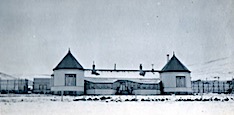Lying three hundred miles east of South America, the
remote islands now known as the Falklands or Las Malvinas were first
discovered by European navigators in the sixteenth century. In the
eighteenth and early nineteenth century the Falklands grew in importance
as a landfall with the commercial exploitation of the South Atlantic and
the development of shipping routes into the Pacific via Cape Horn.
Diverse claims to sovereignty were made, by Britain, France, Spain and
the newly-created Provinces of the River Plate; however, in 1833 Britain
took possession, appointing a Governor in 1841 and a colonial
administration in 1845, with a capital at Port Stanley.
Initially, the commercial value of the Islands lay in the great herds of
wild cattle on East Falkland, and Samuel Lafone, a merchant in
Montevideo, obtained a government contract in 1846 to hunt the cattle,
using gauchos. However, within a few years the cattle had been hunted to
virtual extinction, and the Falkland Islands Company, created in 1851,
with Lafone as one of its directors, turned its attention to sheep
farming.
It was as shepherds on contract that most Scots were to
live in the Falklands. For, by the 1860’s the lands of East and West
Falklands were largely in the hands of the FIC and other major ranching
enterprises which needed shepherds to tend the huge flocks of sheep and
process wool for the British textile industry. For these Scots and other
British shepherds there were few prospects other than to renew contracts
or move on. Much later, in 1891, in a letter home to his father in
Innerleithen, George Anderson wrote:
“No chance of getting any
further advanced, there is no land to be had…..so there is no chance of
becoming one’s own master here.”
Thomas Douglas
Born
1846, Dumfriesshire, Scotland. Emigrated c.1880 to the Falklands with
his wife, Ann Tennant, born 1850 (probably Edinburgh, but from
Newcastle-upon-Tyne), and son Thomas. Moved to Punta Arenas in 1885.
Children, Thomas, William, Margaret, Walter, Jessie, Mary Ann, John,
Annie and James Magellan. His wife is thought to have been the first
qualified nurse to practise in Magallanes. Thomas d. 1898; bur.
Punta Arenas.
William Douglas
b. c1846 Scotland; son of
John Douglas; 1865 hired by Falkland Islands Company; 1866 living at
Darwin Harbour; c1883 moved from Falklands to Patagonia; 1889 inherited
half-share of Useful Station, Estancia Esperanza, Prov. Santa Cruz, from
brother-in-law Thomas Greenshields; d. 1907 Llanfyllin, North
Wales. He married (1881 Falklands) Jane Greenshields; b. 1855
Carmichael, Lanarkshire; dtr. of Robert Greenshields & Elizabeth
Patterson. Their son, Robert Greenshields Douglas died of wounds in
Egypt in 1916. There is a
memorial to this family in
St Bride's
Churchyard
William DOUGLAS was born circa 1846 in Scotland. William started
working for the Falkland Islands Company Ltd in April 1865 in the
Lafonia area on a monthly wage of £3-10-0. He left the Company’s employ
on 1 June 1867. William started working for the Falkland Islands Company
Ltd in the Lafonia area again prior to 1 January 1881. On 30 June 1881
he was paid £32 for taming 16 horses; 27 May 1882 £38 for taming 19
horses; 30 June 1883 £32 for taming 16 horses; and 6 June 1884 £36 for
taming 18 horses. William finished working for the Falkland Islands
Company Ltd in the Lafonia area 6 June 1884 and took a cash order for
£44 for the balance of his account. William, a Scottish stock-hand
living at Bodie Creek, was married to Jane “Jeanie” GREENSHIELDS 14
September 1881 at Douglas Station by Governor's licence according to the
Presbyterian form by Anthony German, Minister. The witnesses were James
Greenshields and W K Cameron. William’s father was recorded as John
Douglas, gentleman farmer, and Jane’s father was recorded as Robert
Greenshields, gentleman and farmer. Jane, age 43, died 1 May 1899 at
Useful Hill, Patagonia. [FIM May 1899; On memorial in St. Bride's
Churchyard, Douglas, Lanarkshire, Scotland] Jane’s brother, Thomas, age
29, died 21 December 1889 and left half of Useful Hill Station to
William; the other half to his brother George. William, age 61 & of
Estancia Esperanza, South America, died 15 August 1907 in Llanfyllin,
North Wales. [On memorial in St. Bride's Churchyard, Douglas,
Lanarkshire, Scotland]
 Estancia Esperanza, c1920
Estancia Esperanza, c1920
Thomas Greenshields
Member of a Scottish
family which owned 42,000 acres in the Falklands. He arrived in
Patagonia in 1884, where he had a ranch at Monte Dinero on the
south-east tip of Santa Cruz. He married Ann McMunn in 1889 but he died
a few months later aged 29, leaving no children. He was buried in Punta
Arenas Public Cemetery, leaving a will bequeathing William Douglas half
of Useful Hill, the other half to his brother George Greeshields and a
share in Douglas Station in the Falklands to his
brother James.
Notes:
1. Douglas is a
settlement on East Falkland, in the Falkland Islands, on the west shore
of Salvador Water. In 1944, Douglas Station was not a family business,
but Douglas Station Ltd, run by Robbie Greenshilds, the manager and
possibly a shareholder. All purchases were bought through the company;
the manager was either paid very little - or nothing at all. The
Falklands Islands Association is based in Douglas House in Douglas
Street, London - a co-incidence?
|


